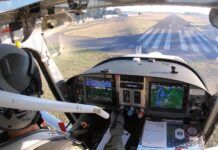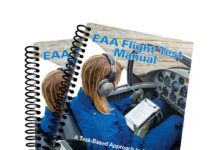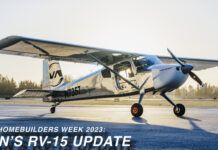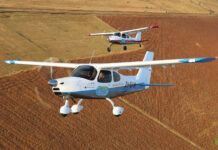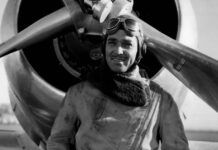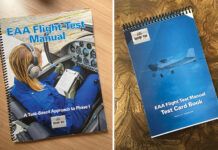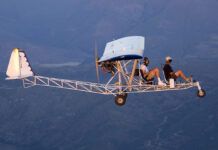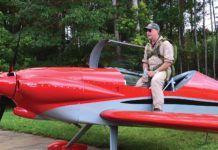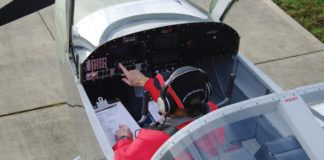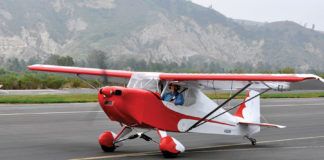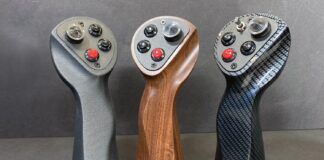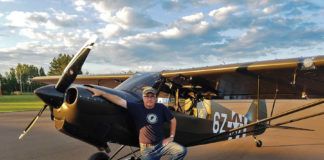Seeing as how we’re all part of the Experimental aviation business here, let’s talk a little about test flying, shall we? Almost everyone who is building an airplane secretly dreams of the day they can swagger across the ramp in a leather jacket, carrying a parachute and a pack of Beeman’s, hop into their cockpit and depart in a blast of wind to challenge the demons of the blue while stretching the ol’ envelope a bit. At least, most everyone has that fantasy—at least once. Then we find that the reality of flight testing is just a little different. In fact, at times it can be downright boring.
You don’t have to be Chuck Yeager to test the average kit aircraft. Much of what you need to learn at the edges of the envelope has already been determined by the factory—assuming you stuck to the plans.
Every aircraft with an Experimental airworthiness certificate has to go through some sort of test period to determine its flying characteristics, performance numbers, and yes—the edges of the envelope. Pilots have been taking new airplanes aloft since, well, the Wright brothers—but still the contents of a good test program are not always understood. You’d think that, by now, there’d be a book that provides an Experimental airplane builder with a step-by-step process for testing their new airplane. But as you’ve probably found out by now (if you’ve looked), there isn’t one that works in all cases. And the reason is, it’s complicated.
No two airplane designs are alike—that’s the first problem. What is important to test in a go-fast cross-country machine may not even be relevant in a tube-and-fabric local flyer. An airplane that started out as a sketch on the builder’s breakfast napkin probably has a little more testing that needs to be done than the 1500th RV-7 to take to the skies. The test program you need to fly is going to depend on a lot of things: the maturity of the design, the uses to which the airplane will be put, and how well you followed the designer’s instructions on engines and weight.
Phase 1 is a test period required by the FAA—it might be 25 hours, it might be 40—but the contents are pretty much left up to the individual. AC 90-89 is a good guideline for getting the airplane safely through its first few flights—but it gets pretty vague after that. As a result, many builders simply go boring holes in the sky, flying off the hours by flying the same test hour 40 times, until they are released from their test box. And to be honest, for some airplanes, not a lot is required. But for many others, this approach is sorely lacking.
The general progression of flight testing for a new aircraft is to first determine that it is controllable and reasonably stable within its normal operating regime, then turn to performance testing to get some basic numbers for stall, climb, glide and cruise, and then to start expanding the envelope in terms of stability and control at different weight and balance conditions and G-loadings. Systems testing (fuel, electrical, and avionics) is also important at this stage to make sure that the engine and essential equipment will keep operating under varying conditions. If the airplane is the first of its kind, most of this is unknown until proven, and part of the envelope expansion is also to determine the airframe’s ability to withstand design loads.
With the advent of popular kit aircraft with thousands of examples flying, the need to do structural envelope testing on individual aircraft is much reduced—so long as the aircraft is built to match the design and plans. If the builder has made modifications to structure, changed the weight limits, installed more (or less) power—well, then more testing is going to be required, as they are once again operating in unknown territory.
But if they’re flying that 1500th RV-7, and it is built to plans, it is probably not essential to go out and try to pull six Gs to prove that the structure will take it. In fact, it is highly unlikely that the average homebuilder/pilot is going to be able to load the airplane up anywhere near the limit loads because they simply won’t have enough lift to do so without exceeding VNE first. That and the fact they’d probably need a G-suit to stay conscious.
A reasonable approach to Phase 1 testing, therefore, is to do that stability and control work—test the handling and stability at both ends of the CG limit box—to make sure that you won’t be surprised the first time you load your cousin in the back seat and take off for lunch. Next, do enough performance testing to understand takeoff and landing distance, climb rates and speeds, and cruise performance. Without this information, you won’t know how fast and far you can go, or how best to deal with high density altitude situations or heavy weights. Finally, if you are flying an aerobatic machine, expanding the envelope of G-loading and handling to a reasonable level is important if you want to develop confidence in the airplane’s ability to stay together—and manageable. But beware—this type of envelope expansion requires that you be in good physical shape to withstand the Gs, and have good stick and rudder skills in case the airplane does something unexpected.
Do we really need to fly to the edges of that ol’ envelope? In most cases, probably not. But it’s important to test at least beyond where you plan to go with passengers; you owe them that much. Knowing that you are operating within a box that you have previously tested takes a lot of the worry out of flying your Experimental aircraft.
You don’t have to be Chuck Yeager to adequately test the average kit aircraft of today. Much of what you need to learn at the edges of the envelope will already be determined by the factory or other builders—assuming, as we always say, that you stuck to the plans. Adequately performing all of the tests necessary to build a good set of cruise tables will take plenty of time just by itself; if you are diligent about it, you might even take more than the required 25 or 40 hours. For many pilots, the challenge of performing flight tests is just as educational and recreational as the build, and they would never think of short-changing the process. In fact, many look for more testing to do—just to hone their skills. Flight testing will build precision in your flying as well as build confidence in—and knowledge about—your airplane.
You might even discover that you like the taste of Beeman’s.



